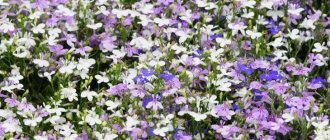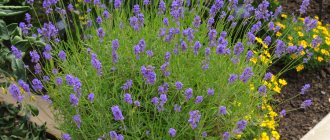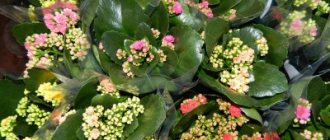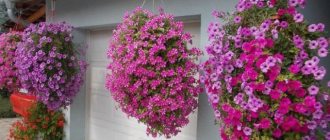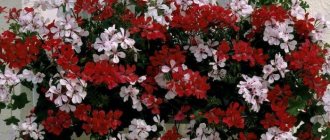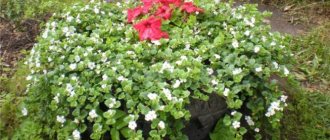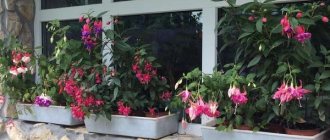Lobelia ampelous belongs to the Campanula family. The genus includes more than 300 species. Most grow in the subtropics and temperate regions. In Russia, in the wild you can find Lobelia Dortmann, sessile leaf. In the climatic conditions of the central zone of our country, the flower is grown as an annual plant. It has earned love among gardeners due to its attractive appearance and long flowering period. It is actively used in landscape design, used to decorate balconies and gardens, summer cottages, alleys, parks, and planted in hanging pots.
Description of ampelous lobelia
The plant is named after the 16th-17th century scientist Matthias de L'Obel. He was the court doctor and botanist of the English king James I.
In its natural habitat it is a tropical perennial plant. The leaves are small, located alternately on hanging shoots. The plates are lanceolate in shape, most often dark emerald in color.
Compact in size, but blooms luxuriantly. The flowers are bisexual, so there is no need for artificial pollination. The buds grow densely along the entire length of the stems. The coloring is varied: from bright to pastel colors.
Ampelous lobelia can be planted singly or in combination with other plants. She calmly tolerates any neighborhood and will perfectly complement any flower arrangement.
Popular varieties
There are many species, but only some of them are cultivated. Almost all of them are hybrids of Lobelia Erinus or Sadovaya. Some of the most beautiful varieties grown under artificial conditions:
| Name | Description | Flowers |
| Sapphire | With hanging branches, up to 35 cm in length. | Small, sapphire with light dots. |
| Blue fountain | It has 6-8 flowing branches with inflorescences. Up to 30 cm long. | Heavenly shade with a white spot in the middle. |
| Red cascade | With strong, well-developed lateral processes reaching 35 cm. | Dark pink or raspberry. Flowering is abundant and long lasting. |
| Blue Sky Regatta | Early variety. Shoots are up to 20-25 cm long. The stems reach 25-30 cm. First they grow upward and then fall down. | Small, collected in multiple inflorescences. Petals are cornflower blue with an amethyst tint. There are also specimens with blue and blue buds. |
| Lilak Spash Regatta | Lilac-snow-white. | |
| Marine Blue Regatta | Undemanding to care. The most important thing is not to oversaturate the soil with moisture and minerals. | Rich blue tone. |
| Regatta Rose | An early variety, the beginning of the growing season is 4 weeks earlier than other species. | Pink with a beige core. |
| Ricciardi | Hybrid. Propagation occurs not by seeds, but by cuttings. The shoots are long and strong. | Various colors. |
| Marquise | A cascade-shaped bush with a dense crown. The stems are hanging, well branched immediately at the base, leafy. Up to 40 cm in length. The leaves are dense, oblong, shiny, and small in size. They are arranged alternately on the shoots. | Purple-scarlet, have 2 lips in structure. They reach 2 cm in circumference. With proper care, they bloom until the first frost. |
| Niagara | The branches of a dense, cascading bush reach 35-40 cm. The greenery is small, bright malachite. Grows along the entire stem. | Small, two-lipped, dark blue or violet. They begin to form in June. |
| Blue cascade | Shoots up to 30-35 cm, highly branched, with developed green mass. The plates are glossy, compacted. | Bright sapphire, small. The inflorescences are located close to neighboring ones, this gives the bush volume. |
Flower varieties
Lobelia comes in several types.
Dwarf
The plant branches heavily, reaches a height of 20 cm. The flowers are small, about 2 cm. The colors are blue, white, purple, pink. This variety, in turn, is divided into two subspecies:
The only important thing for him is that the soil is always moist.
Compact
This variety is in great demand because it can be grown not only in the garden, but also at home, on the balcony. Another compact lobelia is often used to decorate flower beds. It grows no more than 15 cm in height.
It is characterized by abundant and long flowering, which is also a huge plus. The color of the flowers is predominantly blue.
Erect
This variety is distinguished by a straight stem and a height of up to 75 cm. Lobelia of this variety prefers high humidity. For this reason, in wild places, she likes to be located next to bodies of water and wetlands.
Ampelnaya
This type of plant is characterized by the presence of long shoots. It is recommended to use flowers for flower pots and home flower beds. By color there are white, blue with a white eye or heavenly with a white eye.
The variety is quite resistant to temperature changes.
Growing ampelous lobelia from seeds
The seed takes a very long time to hatch, about 80-90 days. Therefore, you need to sow seeds at the end of winter or early spring. In the first case, they need to be germinated under fluorescent lamps, because there is not enough natural light. If sown in March, they will sprout without additional help.
Lobelia seeds are microscopic, so they are sown in groups in wide containers and plates, peat containers. For planting use:
- garden and peat soil in equal quantities;
- soil mixture purchased at the store.
Before sowing, the soil must be disinfected. This can be done in two ways:
- soak in a solution of potassium permanganate;
- heat in the oven.
Growing from seeds step by step:
- Mix the prepared substrate with the same amount of sand.
- Lay out a drainage layer of crushed brick or expanded clay.
- Sprinkle moist soil on top.
- Scatter the seeds over it in small groups.
- Spray with a solution of potassium permanganate or soft warm water from a spray bottle. There is no need to sprinkle a layer of soil on top.
- Cover with glass or film to create greenhouse conditions.
- Place the container in a room at room temperature until germination.
The seeds are sown immediately in a permanent place. This method is called “lazy” among gardeners. With this method, flowering can be expected only in mid-August. Germination will be low.
Sowing is done in late spring. The seeds are mixed with sand and spread over moist soil. Further care for them is the same as when planting indoors.
Preparation for the sowing procedure
For further sowing, you will need to prepare the soil and container.
What primer should I use?
For lobelia, you need to prepare the soil. The flower loves soil with the following characteristics:
You can prepare the soil yourself from soil, humus, river sand and peat in a ratio of 2:2:1:1.
If the soil is highly acidic, it is necessary to add a small amount of wood ash or dolomite flour to it before planting. These components are capable of neutralizing acid.
Before sowing, it is important to disinfect the soil using high temperature. To do this, place in the oven for half an hour, maintaining 90 degrees. Then hold it over steam for 60 minutes.
Selection of capacity
You can sow lobelia in any container; there are no strict requirements for choice. The main thing is that it is spacious and not too deep. Flower growers purchase special containers in stores or adapt something at hand.
The following options are possible:
It is important that the bottom of the container has holes for drainage. They are not required only when using peat cups and tablets.
How to care for seedlings
Growing seedlings from seeds is quite difficult. It is necessary to constantly monitor the growth process:
| Care | Recommendations |
| Shelter | Clean to eliminate fumes from the walls. Keep the seedlings open for 15 minutes twice a day. After the first shoots appear, remove the cover. Do this gradually, increasing the ventilation time every day by several hours. This will strengthen the immunity of young bushes. |
| Watering | Regular and plentiful, because Lobelia has a poorly developed root system. The substrate should not be allowed to dry out. Water the soil through a spray bottle or tray. You need to make sure that there is no stagnation of water. This will cause root rot. |
| Ventilation | When it is warmer than +10 °C outside, take it out onto the balcony, loggia or terrace. Gradually increase the “walking” time; after a week, leave it outdoors for the entire evening and night. Shade young bushes; direct rays of the sun can cause burns and the plants will die. |
| Top dressing | One-time use, 30-40 days after sowing. It is better to use mineral fertilizers purchased in the store. They must be diluted with water in the concentration indicated on the package. After this, spray the bush with the solution. |
| Dive | It is only necessary if the seeds are distributed randomly throughout the container. Transplantation can be done when the seedlings grow 2-3 true leaves. Diving is done in groups of 4-8 bushes. The lobelia root system has the ability to quickly recover. Therefore, to transplant sprouts, you can cut the soil into squares with a blade. Move pieces of soil into larger containers. |
| Trimming | To avoid strong growth of bushes in length, it is necessary to prune shoots that have reached 5-6 cm. If the goal is to obtain long and hanging shoots, there is no need to pinch. After flowering ends, wilted flower stalks must be cut off. This promotes repeated and lush formation of buds. The second time pruning is done in August. If you plan to collect seeds, there is no need to do this (the seed must have time to ripen before the first frost). |
Planting and caring for ampelous lobelia
Planting and caring for a flower must be carried out in compliance with certain rules. Only in this case will the plant grow quickly, bloom, and retain its decorative appearance.
Pots with lobelia should be hung in partial shade so that direct ultraviolet rays do not hit the greenery. The soil should be neutral, the optimal acidity level is 6 ph. It is not recommended to plant bushes in soil enriched with organic matter. This will cause the greenery to quickly gain mass, but the flowers will be inconspicuous and very small.
The shoots are planted at a distance of 30 cm from each other. The bushes quickly grow in width and will soon form decorative thickets.
The flower requires constant care:
- regular watering (the soil mixture should not be allowed to dry out);
- application of fertilizing (potassium mixtures without nitrogen content);
- shortening the shoots in mid-July (after 2 weeks they will grow again and begin to intensively form inflorescences);
- pruning yellowed and fading leaves;
- periodically loosening the soil with a wooden peg (this promotes better penetration of oxygen, the soil will not sour).
Ampelous lobelia is a strong plant with good immunity. If you do not make mistakes in growing, it will not be affected by various diseases. If you follow all the rules, you can observe flowering several times a season.
Mister summer resident advises: how to preserve lobelia for next year
Ampelous lobelia is a heat-loving plant and does not tolerate cold at all. At the first frost it dies. That is why in Russia it is cultivated as an annual.
However, the flower can also be grown as a perennial plant:
- Carefully dig up the bush for the winter.
- Transplant into a pot and place in a warm place.
- After the soil has warmed up, separate the cuttings.
- Root them in nutritious soil.
- When the shoots get stronger, plant them in a permanent place, following the recommendations given in the chapter “Planting and caring for ampelous lobelia.”
In the southern regions of Russia, the flower can winter outside. Provided that the air temperature does not drop below zero. To prevent freezing after the growing season, it is advisable to mulch the tree trunk circle with peat, spruce branches, wood shavings or straw.
What is this flower
Lobelia is one of the most popular types of flowers for the garden or cottage.
Lobelia is one of the popular plants among gardeners. It attracts attention with its delicate flowers, which grow in dense groups, and the ampelous forms hang beautifully from the flower pots, reminiscent of a waterfall. This plant is a perennial shrub of the Bellflower family, which in our country is grown, in most cases, as an annual. The flower's homeland is South Africa, where the flower grows on wet and rocky cliffs, although it can be found almost all over the world in tropical and temperate climates. In total, there are about 300 species of lobelia, of which only 20 are cultivated.

